-
$
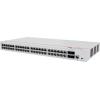
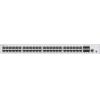
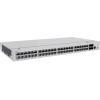
Huawei S220-48P4X is a managed switch from the eKitEngine series. It comes with 48 gigabit Ethernet ports (10/100/1000 Mb/s) and 4 SFP+ slots (10 Gb/s). All Ethernet ports support PoE+, with a maximum power per port of 15.4 W for 802.3af or 30 W for 802.3at. The total power budget for the entire device is 380 W, significantly more than what the S110 series offers. The switch provides robust network security, supporting various authentication methods (based on MAC address or 802.1X) and protection against external attacks. Management can be done through the Web UI, CLI, SNMP, and cloud-based management, including the Huawei eKit app. The S220-48P4X is mainly intended for use as an access switch in networks with multiple APs, offering a large power budget and high throughput thanks to its SFP+ slots. In smaller networks, it can serve as the primary switch, providing both PoE and basic management capabilities.
48x gigabit Ethernet, 4x SFP+
The switch is equipped with 48 gigabit Ethernet ports (10/100/1000 Mb/s) and 4 SFP+ slots (10 Gb/s). It has a switching capacity of 176 Gb/s and a packet forwarding speed of 131 Mp/s. The SFP+ slots provide high-speed connectivity, up to 10 Gb/s, enabling connections between network segments or efficient devices such as servers.
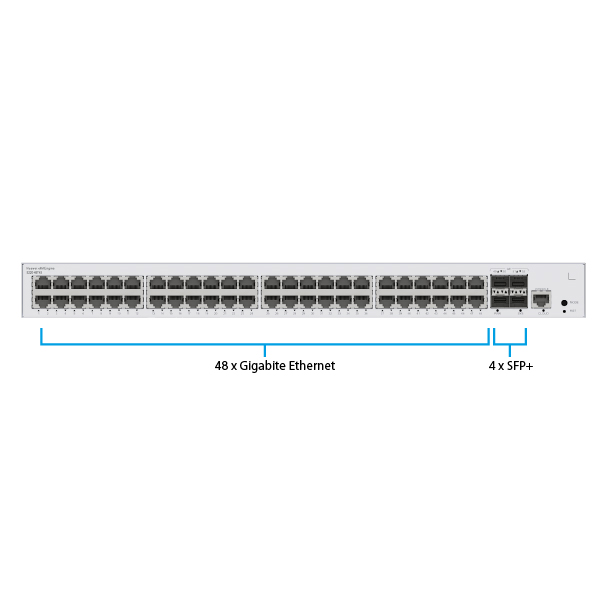
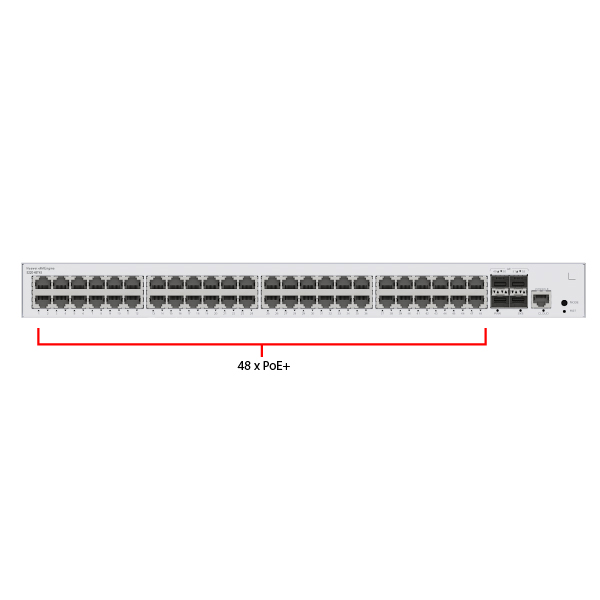
48 PoE+ outputs
On all Ethernet ports, there is PoE+ power output available. The maximum power output per port, according to standards, is 15.4 W for 802.3af or 30 W for 802.3at. The total power budget for the entire device is 380 W, significantly more than what solutions from the S110 series offer. This is sufficient for connecting 24 APs using the 802.3af standard, and in most cases, you can even connect more devices, as power consumption typically remains below 15 W.
The use of PoE allows you to power and transmit data through an Ethernet cable. With this type of switch, you only need to run one cable to each access point, eliminating the need for additional power supplies.
Layer 2 management
The device provides numerous Layer 2 management features, such as VLAN support, multicast support (IGMP Snooping), Quality of Service (QoS) functions, and Access Control Lists (ACLs). It supports Spanning Tree protocols (STP / RSTP / MSTP) as well as the modern standard ERPS (Ethernet Ring Protection Switching) defined in the ITU-T G.8032 standard.
The switch provides essential network security measures. It protects against DoS attacks such as SYN flood, Land, Smurf, and ICMP flood. Additionally, it has safeguards against attacks targeting users, including DHCP server attacks, IP/MAC spoofing, DHCP request floods, and DHCP CHADDR attacks.
Management can be performed through the Web UI, CLI, or using SNMP (v1, v2c, v3) / SSHv2.0. S220 series devices can also be managed in the cloud, allowing you to additionally utilize the Huawei eKit app.
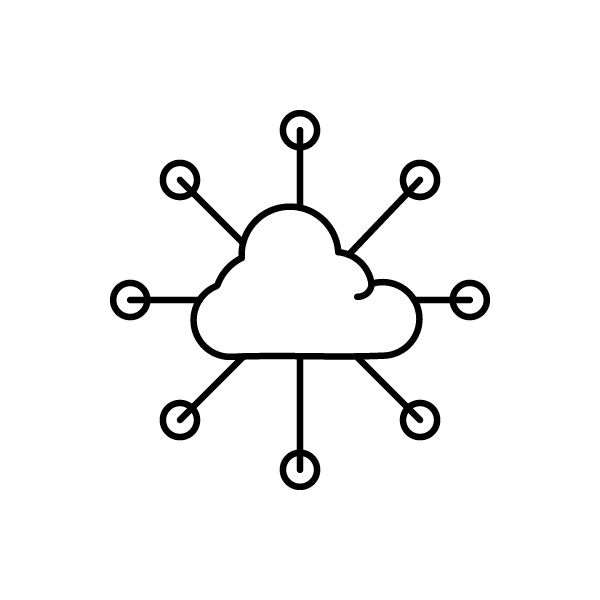
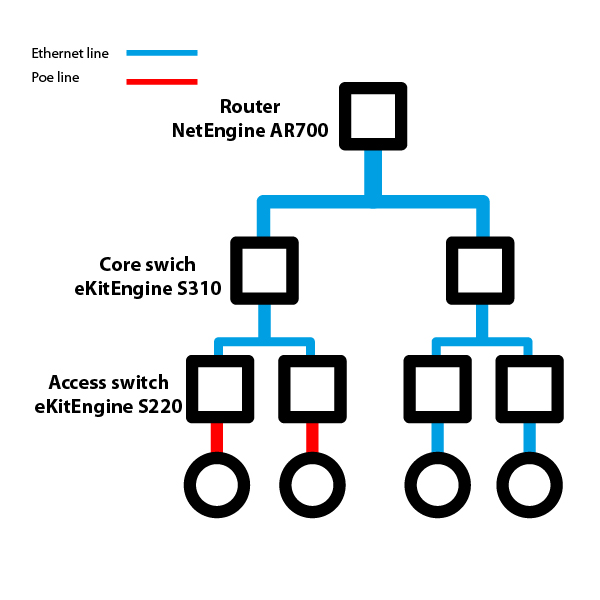
Usage
The S220-48P4X is designed to function as an access switch in networks consisting of multiple eKitEngine APs. Access to Layer 2 management allows you to control and monitor the operation of the entire network. With eKitEngine solutions, management can be consolidated into a single interface, simplifying system configuration and maintenance.
Thanks to its large power budget, the S220-48P4X allows you to easily connect 24 access points, and in most situations, even more. The switch is suitable for large networks, such as those found in hotels or schools. On the other hand, with access to management features, it can function as the sole switch in small and medium-sized networks, eliminating the need for separate core and access switches.
Specifications
| Huawei S220-48P4X | |
| Switching Capacity | 176 Gb/s |
| Packet forwarding | 131 Mp/s |
| Fixed port |
48x gigabit Ethernet 10/100/1000 Mb/s with PoE+ 4x SFP+ (10 Gb/s) |
| Chassis dimensions (H x W x D) | 43.6 mm x 442 mm x 220 mm |
| Chassis height | 1U |
| Weight | 4,29 kg |
| Power module type | Built-in AC power module |
| Rated voltage | 100 - 240 V AC, 50/60 Hz |
| Maximum voltage | 90 - 29 V AC, 45/65 Hz |
| Maximum power consumption | Without PoE: 64.7 W With PoE: 462.8 W (PoE: 380 W) |
| Noise | Sound power at normal temperature: 49.3 dB (A) Sound power at high temperature: 63 dB (A) |
| Long-term operating temperature | –5°C to +50°C |
| Storage temperature | –40°C to +70°C |
| Relative humidity | 5% to 95% (noncondensing) |
| Service port surge protection | Common mode: ±10 kV |
| Power port surge protection | Differential mode: ±6 kV Common mode: ±6 kV |
| Heat dissipation mode | Air cooling, intelligent fan speed adjustment |
| Service features | |
|---|---|
| MAC address table | Automatic MAC address learning and aging 16K MAC address entries at maximum Static, dynamic, and blackhole MAC address entries Source MAC address filtering Limitation on the number of MAC addresses learned by an interface |
| VLAN features | 4094 VLANs Voice VLAN VLAN assignment based on MAC addresses, protocols, IP subnets, policies, and ports VLAN stacking |
| Ethernet switching | G.8032 Ethernet Ring Protection Switching (ERPS) STP (IEEE 802.1d), RSTP (IEEE 802.1w), and MSTP (IEEE 802.1s) BPDU protection, root protection, and loop protection BPDU tunnel |
| Multicast | IGMPv1/v2/v3 and IGMPv1/v2/v3 snooping |
| Reliability |
LACP (Link Aggregation Control Protocol) LLDP (Link Layer Discovery Protocol) |
| QoS/ACL | Traffic rate limiting in the inbound and outbound directions of a port Packet redirection Port-based traffic policing and two-rate three-color CAR Eight queues on each port DRR, SP, and DRR+SP queue scheduling algorithms Re-marking of 802.1p and DSCP priorities for packets Packet filtering on Layer 2 to Layer 4, filtering out invalid frames based on the source MAC address, destination MAC address, source IP address, destination IP address, TCP/UDP source/destination port number, protocol, or VLAN |
| Security features | Hierarchical user management and password protection Defense against DoS, ARP, and ICMP attacks Binding of the IP address, MAC address, port ID, and VLAN ID Port isolation, port security, and sticky MAC Blackhole MAC address entries Limitation on the number of learned MAC addresses IEEE 802.1X authentication and limit on the number of users on an interface Multiple authentication modes including AAA, RADIUS, HWTACACS and NAC authentication SSH v2.0 HTTPS CPU protection Blacklist and whitelist DHCP client and DHCP snooping |
| Management and maintenance |
Cloud management based on NETCONF/YANG Virtual cable test (VCT) Remote configuration and maintenance by using Telnet SNMPv1/v2/v3 Web system-based management HTTPS LLDP/LLDP-MED System logs and alarms based on severities IEEE 802.3az: Energy Efficient Ethernet (EEE) Port mirroring Deployment through the registration query center |






 Polski
Polski English
English Italiano
Italiano Español
Español Čeština
Čeština Српски
Српски Deutsch
Deutsch Ελληνικά
Ελληνικά Slovenský
Slovenský




